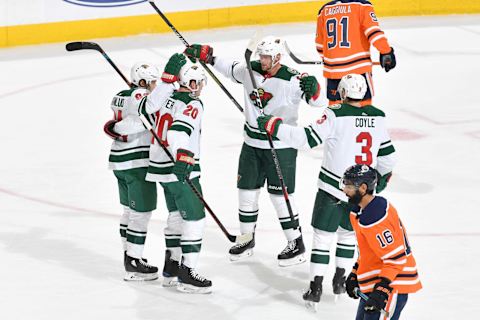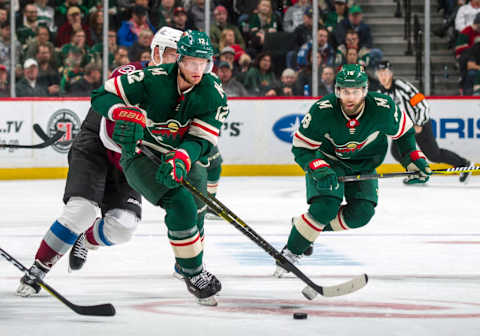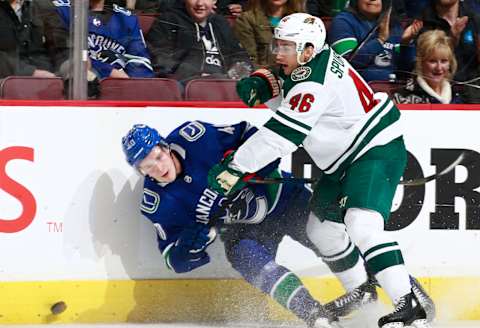Minnesota Wild: Defying the statistics of a top-half team this season


The Minnesota Wild are sitting comfortably in 8th place in the NHL presently, which equates to 2nd in the Central Division and 5th in the ever-strong Western Conference.
What is defying logic when it comes to the Minnesota Wild is the fact that based on certain team statistics, they have no right to be as high up the ladder as they are.
Their impressive form isn’t going unnoticed, although for a few weeks there, they were flying under the radar. In the most recent Power Rankings, one media outlet had them ranked in 3rd, with nobody placing them outside of the top ten.
In terms of their form, there are a lot of things it can be attributed to; strong goaltending, scoring coming from not just their offense, but defence as well, players like Mikael Granlund being sneaky good and of course, a revitalised Zach Parise scoring at a clip he hasn’t done so in years.
All of those factors add up to put the Minnesota Wild in a very competitive spot early-on. This isn’t anything new though. What remains to be seen is, should they make the play-offs, which at the moment seems likely; can they perform at the necessary level to escape the first round and make an impact?
What we have with the Minnesota Wild is an ageing core group of players; none are getting any younger and questions are being asked as to whether a rebuild is due.
Delving beyond the superficial surface layer of the eye-test and opinions being shared by the press, there are some key statistics that the Minnesota Wild are under-performing in.
When I say under-performing, we’re looking at the fact that typically a team in the upper echelons of the league meets these criteria.
Of course, the Wild may well be an outlier, this could be a product of Bruce Boudreau‘s systems or just as equally the group of players at his disposal and the fact that getting the best out of them isn’t necessarily the same as getting the best out of say Auston Matthews, John Tavares and company in Toronto or Jonathan Toews, Patrick Kane and company in Chicago.
As such, the Minnesota Wild make for an interesting study into what really is required to be a competitive team in this league, ’cause they sure as heck don’t fit the mould right now!

Minnesota Wild need to improve their power-play
The Minnesota Wild are among a group of only six teams in the top half of the league with a power-play percentage that isn’t also top half of the league.
Now obviously, we’re still early days in terms of a sample size, but top of the league on the power-play are Alex Ovechkin and the Washington Capitals, converting on 34% of their looks with an extra-man.
The fact that Central Division rivals, the Winnipeg Jets and St. Louis Blues rank second and third respectively shows that having a strong power-play is only a component of success; they sit 17th and 26th in the standings respectively.
More from Analysis
- Here we go. Minnesota Wild head into pivotal Game 5 matchup
- Yeah, Game 2 was ugly. How will the Minnesota Wild respond at home?
- Fleury injury just the latest hurdle for the struggling Minnesota Wild so far
- Minnesota Wild to get a test with challenging homestand
- Minnesota Wild: Filip Gustavsson gets his time to shine in net
However, there’s something to be said about the fact 9 of 15 teams in the top half of the standings have a power-play that also ranks in the top half of the standings.
Year on year though, there is proof to the notion that a team can make the play-offs without an elite power-play.
Last year, the Minnesota Wild, Anaheim Ducks and San Jose Sharks all comfortably made it to the post-season. None of those teams were in the league’s top 15 power-play teams across the course of the year.
If you look at the make-up of the Minnesota Wild power-play unit, there is no one goalscorer, barring maybe Zach Parise that can be marked as the guy that you want to get the puck to when on the man-advantage.
Matt Dumba and Ryan Suter are perfectly suited to quarter-backing a power-play group, but you need to build it from them out, not be reliant on them.
Ideal world, you’d find a play-maker you could trade for; someone who can dish the puck around, get the opposition’s goaltender moving about and opening up some shooting lanes.
Realistically, you’re looking toward bigger guys like Jordan Greenway to limit their visibility and be an immovable object in front of net as your key power-play tactic and that’s where it’s falling down.

Minnesota Wild have to limit shots on their net
It seems absurd that the Minnesota Wild sit so high in the league standings when they’re allowing the 11th-worst shots against per game.
If they keep it up, Devan Dubnyk (mainly) and Alex Stalock are going to be burnt out before we get anywhere near the post-season. We’ve all seen what that looks like and it’s not pretty.
Right now, the Minnesota Wild are giving up an average of 32.6 shots per game. For comparison sake, the league worst are the Ottawa Senators who give up 39.1 per game, but are playing a line-up laden with rookies after seeing a complete re-fit in terms of big-name talent. At the top end of this statistic are the Carolina Hurricanes at 24.3 per game and the Vegas Golden Knights at 24.9 per game.
Interestingly, neither of those top two teams in terms of shots against are at the top of the actual ladder, which I guess says a lot about the quality of the shots you give up. That and your goal-tending.
In their Stanley Cup winning seasons, the Washington Capitals surrendered 31.9 shots per game, the Pittsburgh Penguins, the year before were at 32.6, much like the Wild currently.
So, it’d appear that as long as the shots you give up aren’t high-danger that you could legitimately have a number that ranks poorly in the league and still have massive success.
It would however be in Minnesota’s best interests to try to limit the shots that get through to their goalies. The more work a goalie does, the more chance he tires in the post-season.
Looking at one final statistic in this realm; the team’s Scoring Chances Against (courtesy of Natural Stat Trick), you’ll actually find the Minnesota Wild sitting as the third best team in the league for limiting the scoring chances.
Shots don’t actually tell the full story in that sense. Only the Florida Panthers and Boston Bruins give away less chances.
Conclusion here though is that regardless of the fact they limit scoring chances, they’d be wise to also limit shots against. Neither are favourable statistics when there’s a risk of the puck going in the net!

Minnesota Wild can’t keep taking penalties
Maybe it’s just the make-up of the Western Conference and further to that, the Central Division, but the Minnesota Wild are giving up a lot of penalties.
Per 60 minutes, they’re in the top five for the penalty minutes they’ve taken, giving up an average of 4.14 minor penalties in that time.
If we do some quick maths based on the fact they’re all two-minute minors, that’s somewhere around eight minutes a night that you’re potentially short-handed. Granted, that is very rough maths as it doesn’t factor in the other team scoring a power-play marker or if there are coincidental penalties to name a few scenarios.
However, ignoring the other scenarios, eight minutes a night short-handed isn’t good for anyone.
At 85.2%, the Minnesota Wild have the fourth-best penalty-kill in the entire league, but do you really want to be putting them out there and relying on that percentage to remain the same?
Probably not.
The team needs to ease up on the number of penalties it gives up each night, starting with the fourth line – both Eric Fehr and Matt Hendricks give up more than a minute of penalty time per game played.
As a team, the Minnesota Wild can take some comfort from the fact that the previous two Stanley Cup winners were ranked within the top twelve teams in terms of penalty minutes they’d conceded per 60 minutes.
The Washington Capitals last year were the 7th worst team for minor penalties per 60 minutes – there is of course hope that the Wild replicate that and continue to penalty-kill at a high percentage.
In all honesty, it’d be nicer if they kept the penalty-killing down and kept the percentage high that way instead.
dark. Next. Eric Staal the latest to join the 400 goal club
Statistically, they’re not the best team, in fact the Minnesota Wild are quite average in a lot of areas. But the one that counts – the standings; that’s looks decidedly above average right now!
Statistics courtesy of NHL.com and Natural Stat Trick.